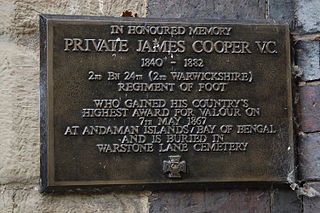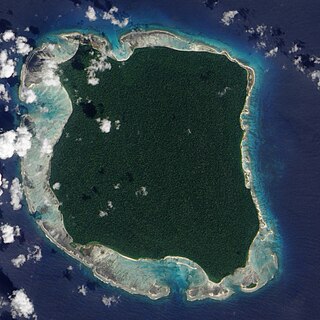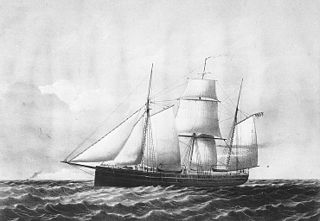
The Andaman Islands are an archipelago, made up of 200 islands, in the northeastern Indian Ocean about 130 km (81 mi) southwest off the coasts of Myanmar's Ayeyarwady Region. Together with the Nicobar Islands to their south, the Andamans serve as a maritime boundary between the Bay of Bengal to the west and the Andaman Sea to the east. Most of the islands are part of the Andaman and Nicobar Islands, a Union Territory of India, while the Coco Islands and Preparis Island are part of the Yangon Region of Myanmar.

James Cooper VC was an English recipient of the Victoria Cross, the highest and most prestigious award for gallantry in the face of the enemy that can be awarded to British and Commonwealth forces.

Campbell Mellis Douglas, was a Canadian recipient of the Victoria Cross, the highest and most prestigious award for gallantry in the face of the enemy that can be awarded to British and Commonwealth forces. The awarding of the VC to Douglas was one of the few instances of the VC being awarded for actions taken not in the face of the enemy.

Thomas Murphy VC was an Irish recipient of the Victoria Cross, the highest and most prestigious award for gallantry in the face of the enemy that can be awarded to British and Commonwealth forces.

Woodes Rogers was an English sea captain, privateer and colonial administrator who served the governor of the Bahamas from 1718 to 1721 and again from 1728 to 1732. He is remembered as the captain of the vessel that rescued marooned Scottish sailor Alexander Selkirk, whose plight is generally believed to have inspired Daniel Defoe's novel Robinson Crusoe. Rogers came from an experienced seafaring family, grew up in Poole and Bristol, and served a marine apprenticeship to a Bristol sea captain. His father held shares in many ships, but he died when Rogers was in his mid-twenties, leaving Rogers in control of the family shipping business.

William Griffiths VC was an Irish recipient of the Victoria Cross, the highest and most prestigious award for gallantry in the face of the enemy that can be awarded to British and Commonwealth forces.

North Sentinel Island is one of the Andaman Islands, an Indian archipelago in the Bay of Bengal which also includes South Sentinel Island. The island is a protected area of India. It is home to the Sentinelese, an indigenous tribe in voluntary isolation who have defended, often by force, their protected isolation from the outside world. The island is about 8 kilometres (5.0 mi) long and 7 kilometres (4.3 mi) wide, and its area is approximately 60 square kilometres (23 sq mi).

The Sentinelese, also known as the Sentineli and the North Sentinel Islanders, are an indigenous people who inhabit North Sentinel Island in the Bay of Bengal in the northeastern Indian Ocean. Designated a particularly vulnerable tribal group and a Scheduled Tribe, they belong to the broader class of Andamanese peoples.

The Andamanese are the various indigenous peoples of the Andaman Islands, part of India's Andaman and Nicobar Islands, the union territory in the southeastern part of the Bay of Bengal. The Andamanese are a designated Scheduled Tribe in India's constitution.

The first USS Advance was a brigantine in the United States Navy which participated in an Arctic rescue expedition. Advance was built in 1847 as Augusta in New Kent County, Virginia and loaned to the Navy on 7 May 1850 by Henry Grinnell to participate in the search for Sir John Franklin's Arctic expedition which had been stranded in the frozen north since 1846. After last-minute preparations, the ship, under the command of Lieutenant Edwin J. De Haven and in company with Rescue, put to sea from New York on 23 May 1850.

USS Niphon was a steam operated vessel acquired by the Union Navy during the American Civil War. She was used by the Navy to patrol navigable waterways of the Confederacy to prevent the South from trading with other countries.

The Imperial Trans-Antarctic Expedition of 1914–1917 is considered to be the last major expedition of the Heroic Age of Antarctic Exploration. Conceived by Sir Ernest Shackleton, the expedition was an attempt to make the first land crossing of the Antarctic continent. After Roald Amundsen's South Pole expedition in 1911, this crossing remained, in Shackleton's words, the "one great main object of Antarctic journeyings". Shackleton's expedition failed to accomplish this objective but became recognized instead as an epic feat of endurance.

A castaway is a person who is cast adrift or ashore. While the situation usually happens after a shipwreck, some people voluntarily stay behind on a desert island, either to evade captors or the world in general. A person may also be left ashore as punishment (marooned).

SY Aurora was a 580-ton barque-rigged steam yacht built by Alexander Stephen and Sons Ltd. in Dundee, Scotland, in 1876, for the Dundee Seal and Whale Fishing Company. It was 165 feet (50 m) long with a 30-foot (9.1 m) beam. The hull was made of oak, sheathed with greenheart and lined with fir. The bow was a mass of solid wood reinforced with steel-plate armour. The heavy side frames were braced by two levels of horizontal oak beams. Its primary use was whaling in the northern seas, and it was built sturdily enough to withstand the heavy weather and ice that would be encountered there. That strength proved useful for Antarctic exploration as well and between 1911 and 1917 it made five trips to the continent, both for exploration and rescue missions.

David Bell VC (c. 1845 – 7 March 1920) was born County Down, Ireland. Bell was a recipient of the Victoria Cross, the highest and most prestigious award for gallantry in the face of the enemy that can be awarded to British and Commonwealth forces.
SS Norwich City was a British cargo steamship. She was built in 1911 as Normanby, and renamed Norwich City in 1919. She was wrecked in the Pacific Ocean in 1929. For many years her wreck was a sea mark on the atoll of Nikumaroro. The wreck is now largely broken up.

The McClure Arctic expedition, one of many attempts to find the missing Franklin expedition, was significant for being the first to successfully discover and transit the Northwest Passage, which it accomplished by both boat and sledging.

The Battle of Drummond's Island was a conflict between the United States Exploring Expedition and the village of Utiroa on April 1841 at Drummond's Island, Tabiteuea North, which is now part of Tabiteuea. The cause of the conflict was the disappearance of the American seaman John Anderson, who was suspected, with no evidence, to have been murdered by the village natives. In retaliation, the members of the expedition killed twelve of the natives and burned the village of Utiroa to the ground.
Lewis Raphael Rickinson was an English marine engineer. He is best known for his service in the Imperial Trans-Antarctic Expedition of 1914–1916, for which he was awarded the Silver Polar Medal.
Madhumala Chattopadhyay is an Indian anthropologist who specializes in the Indigenous peoples of the Andaman and Nicobar Islands. In 1991, Chattopadhyay and her colleagues were the first outsiders to make peaceful contact with the Sentinelese people.















